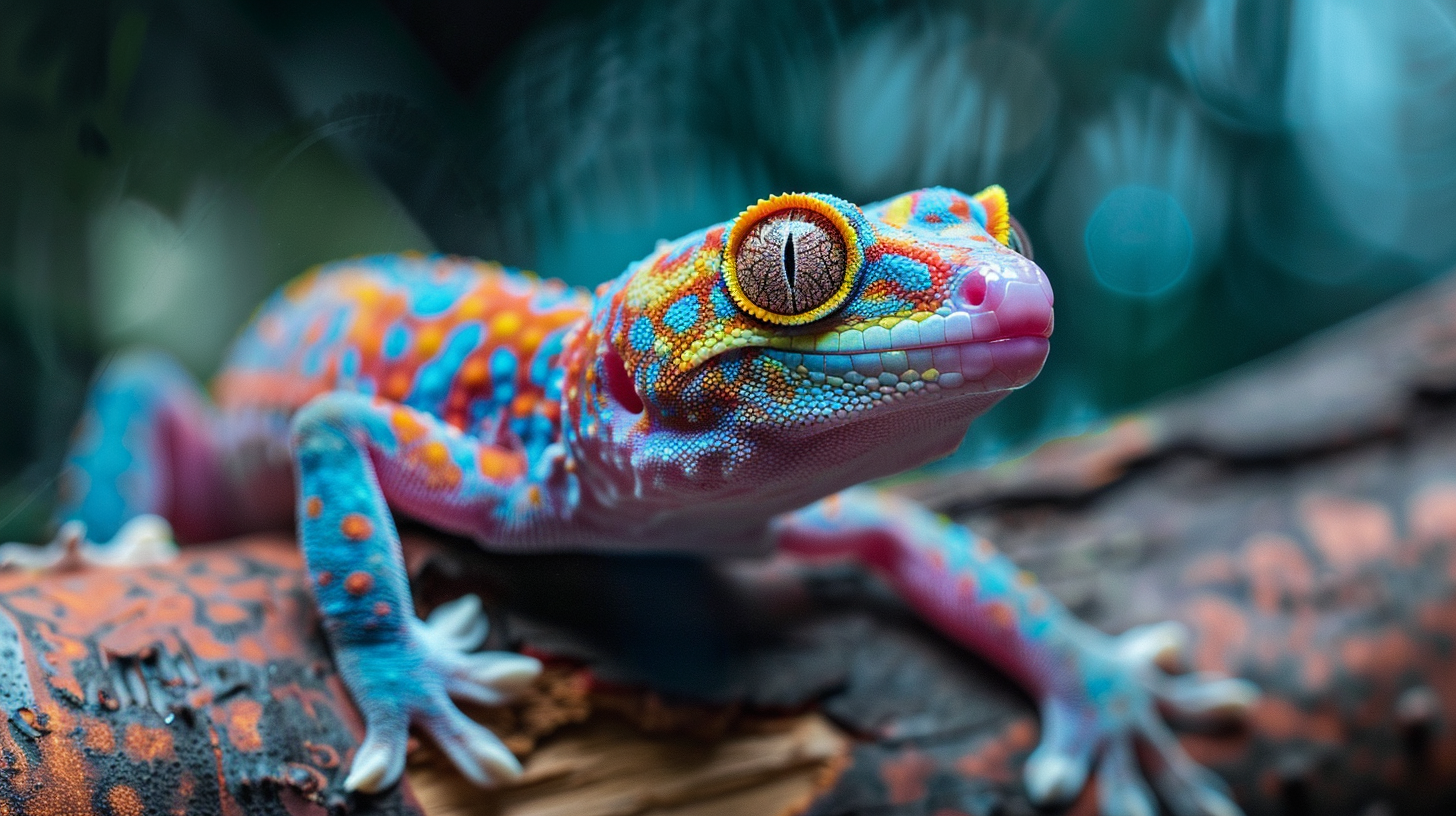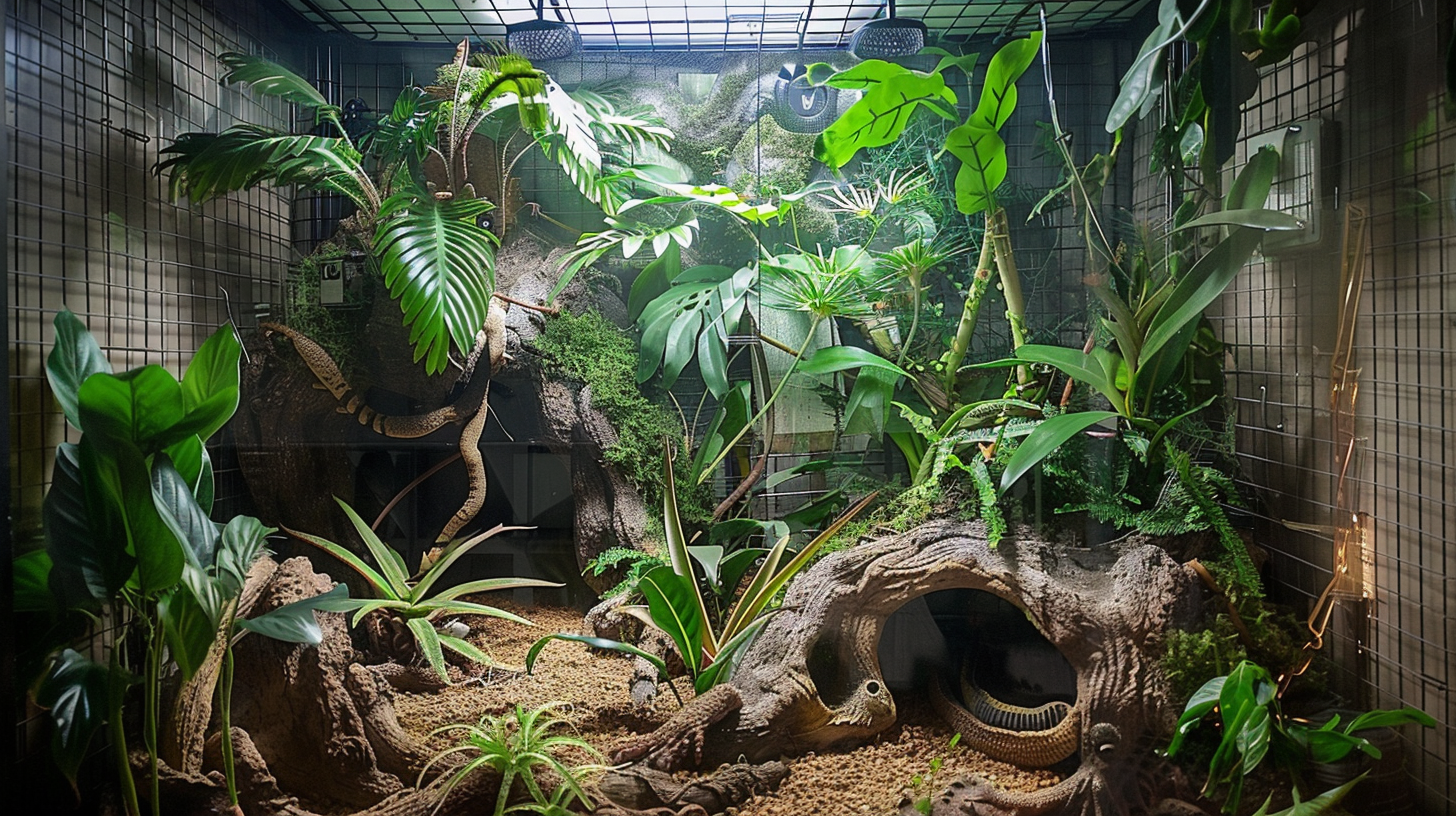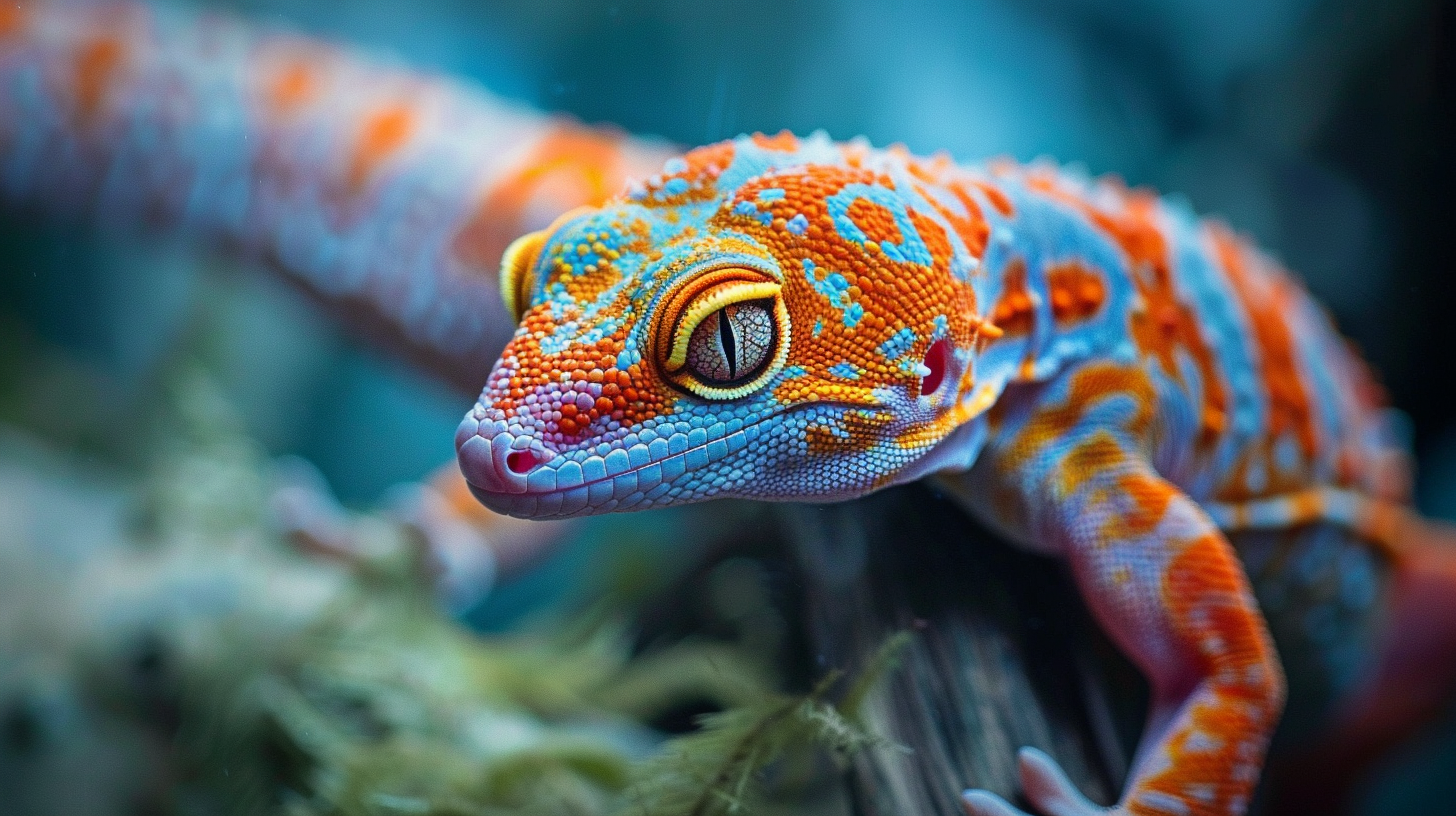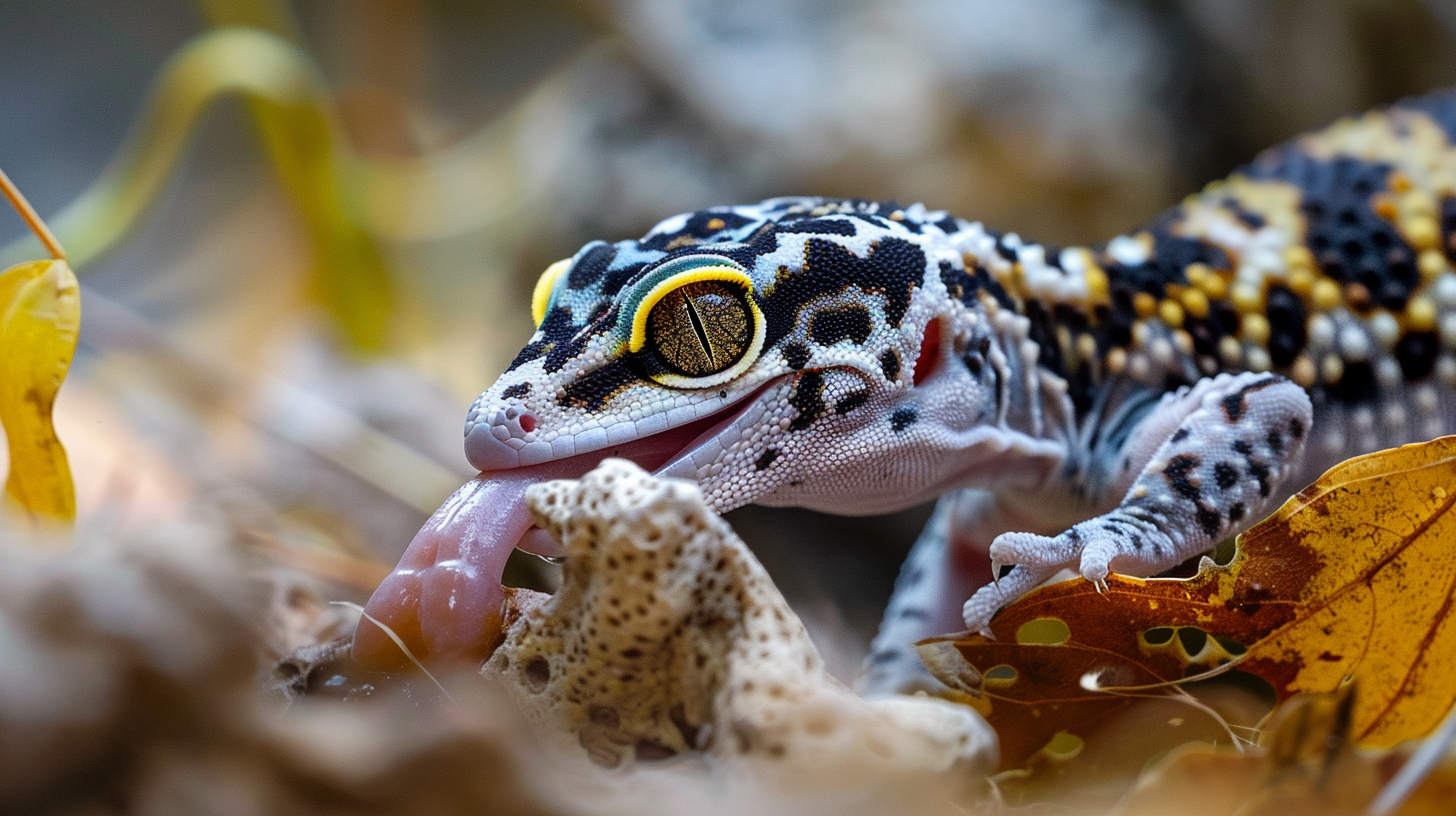Understanding the essentials of gecko pet care starts with setting up a suitable environment and ensuring proper temperature and lighting needs. This section covers these foundational aspects for keeping your gecko healthy and comfortable.
Setting Up the Enclosure
Creating a proper gecko habitat setup is crucial for your pet’s well-being. Leopard geckos, for instance, should be housed in an appropriately sized tank, aquarium, terrarium, or vivarium.
For a single fully-grown adult gecko, an enclosure that is over 2 feet (60 cm) long is ideal (Leopard Gecko Care). The height should allow for unrestricted movement. Here’s a quick guide on the appropriate tank sizes for different stages of a gecko’s life:
| Gecko Stage | Recommended Tank Size |
|---|---|
| Young Geckos | 20 gallons |
| Adult Geckos | 40-50 gallons |
The enclosure should include:
- Heating: A heat mat covering about one-third of the total ground space to create a warm side and a cooler side, allowing the gecko to regulate its body temperature.
- Flooring: Safe substrate options like reptile carpet, paper towels, or tiles to prevent impaction.
- Ventilation: Adequate airflow to prevent mold growth and maintain humidity levels.
- Access: Front-opening tanks are preferable for easier access and cleaning (Terrarium Quest).
Temperature and Lighting Needs
Maintaining proper temperature and lighting is essential for the health of your gecko. Leopard geckos thrive in a well-regulated environment. Here are the key points:
- Temperature: The tank should have a hot spot with temperatures between 90-95°F and ambient temperatures around 80°F. Nighttime temperatures can drop to as low as 70°F (Jabberwock Reptiles).
- Heating Devices: Use heat tapes, under-tank heaters, or low-level basking lights to maintain the required temperature range (VCA Hospitals).
- Lighting: While leopard geckos do not require UVB lighting, providing a day-night cycle with a regular light source can help regulate their behavior and metabolism.
Here’s a summary table for easy reference:
| Temperature Zone | Ideal Temperature (°F) |
|---|---|
| Hot Spot | 90-95 |
| Ambient Daytime | 80 |
| Nighttime | 70 |
Maintaining these conditions will support your gecko’s health and longevity. For more information on gecko care, visit our gecko handling and taming and gecko habitat setup pages.
By following these guidelines, you can provide a comfortable and safe environment for your gecko, ensuring their well-being and happiness.
Feeding and Nutrition
Proper feeding and nutrition are essential for the well-being of your leopard gecko. Understanding their dietary needs and feeding schedule ensures they remain healthy and active.
Ideal Diet for Leopard Geckos
Leopard geckos primarily feed on live, moving insect prey. Their diet should include a variety of insects to provide balanced nutrition. Here are some of the preferred insects for leopard geckos:
- Crickets: A staple in their diet, crickets are readily available and nutritionally suitable.
- Mealworms: Another common feeder insect, mealworms are easy to store and handle.
- Silkworms: Rich in protein and low in fat, silkworms are an excellent choice.
- Roaches: Nutritious and relatively easy to breed, roaches make a good addition.
- Superworms: High in fat, superworms should be given sparingly as treats.
- Waxworms: Also high in fat, waxworms should be reserved for occasional treats (Exotic Direct).
It’s important to avoid over-relying on fatty insects like waxworms and superworms. Butterworms should also be given sparingly due to their poor calcium content and potential for addiction in geckos (Exotic Direct).
Feeding Schedule and Portions
The feeding schedule and portions for leopard geckos vary based on their age and size. Here is a general guideline:
| Age | Feeding Frequency | Portion Size |
|---|---|---|
| Juveniles (up to 6 months) | Daily | Two insects for every inch of body length |
| Sub-adults (6-12 months) | Every 1-2 days | Two insects for every inch of body length |
| Adults (12+ months) | 2-3 times per week | Two insects for every inch of body length |
Figures courtesy Exotic Direct
Feeding schedules should be adjusted based on the individual gecko’s needs and activity levels. Monitoring their weight and overall health can help determine if adjustments are necessary.
For more detailed information on feeding practices, visit our article on feeding geckos as pets.
Ensuring your leopard gecko receives a balanced diet and appropriate feeding schedule is crucial for their health and longevity. Regularly offering a variety of live insects and monitoring their intake will help maintain their well-being. Be sure to explore related topics such as gecko handling and taming and gecko habitat setup for comprehensive pet care insights.
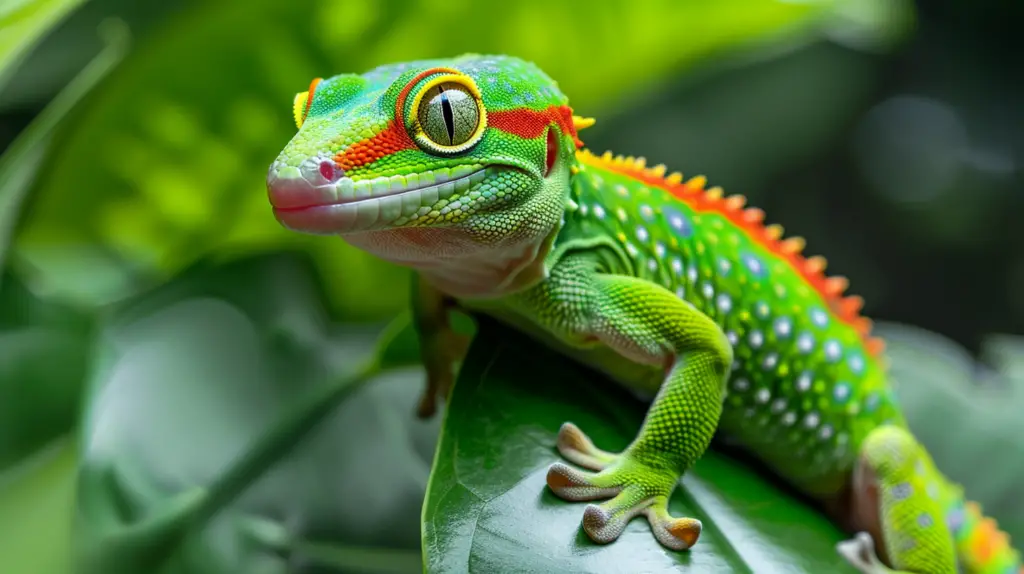
Health and Wellness
Ensuring the health and wellness of your gecko is paramount for their longevity and quality of life. Being knowledgeable about common health issues and signs of illness can make a significant difference in effective gecko pet care.
Common Health Issues
Geckos, like all pets, can face specific health challenges. Below are some common health issues that gecko owners should be aware of:
Impaction
Impaction is the number one health problem in geckos. It occurs when geckos ingest something indigestible, such as sand from their tank or a food item too large for their gut. Impaction can be fatal if not treated promptly. To prevent impaction, avoid using loose substrates and ensure that food items are appropriately sized (My Family Vets).
Internal Parasites
Internal parasites can be transmitted through contact with infected geckos or consuming poor quality food. Symptoms include regurgitation, weight loss, loss of appetite, and lethargy. A specialist reptile veterinarian can prescribe deworming treatments or medications to eliminate the parasites (My Family Vets).
Respiratory Infections
Respiratory infections can occur if the temperature in the gecko’s enclosure is not suitable for their species. Signs include lethargy, loss of appetite, and difficulty breathing. It’s essential to monitor and maintain the correct temperature using a reptile thermometer to prevent respiratory issues (My Family Vets).
Difficulty Shedding
Geckos may experience difficulty shedding, leading to excess skin clinging to their toes, feet, head, or tail. This can be painful and damaging, potentially causing them to lose toes. Gentle removal of the shed by soaking or spraying the affected area with warm water can help soften and remove the excess skin (My Family Vets).
Metabolic Bone Disease (MBD)
MBD in geckos results from a diet low in calcium and vitamin D3, causing soft, rubbery bones that cannot support the gecko’s weight. Symptoms include distorted limbs and difficulty raising the body off the ground. MBD is preventable by providing a diet rich in calcium and vitamin D3 (My Family Vets).
| Health Issue | Symptoms | Prevention/Treatment |
|---|---|---|
| Impaction | Lethargy, bloating, lack of appetite | Avoid loose substrates, appropriate food sizing |
| Internal Parasites | Regurgitation, weight loss, lethargy | Deworming treatments, high-quality food |
| Respiratory Infections | Lethargy, loss of appetite, difficulty breathing | Maintain appropriate temperatures |
| Difficulty Shedding | Excess shed on toes, feet, head, tail | Soak or spray affected areas with warm water |
| Metabolic Bone Disease | Distorted limbs, difficulty raising body off the ground | Diet rich in calcium and vitamin D3 |
Signs of Illness to Watch For
Recognizing early signs of illness can help you take swift action to ensure your gecko’s health. Here are some symptoms to watch for:
- Lethargy: A normally active gecko that becomes unusually lethargic may be unwell.
- Loss of Appetite: Sudden or gradual loss of interest in food can indicate various health issues.
- Weight Loss: Noticeable weight loss without a change in diet or activity level is a red flag.
- Difficulty Breathing: Labored breathing or open-mouth breathing can signal respiratory issues.
- Abnormal Shedding: Excess skin remaining after shedding, particularly around the toes and tail.
- Distorted Limbs: Soft, rubbery bones or limbs that appear distorted can indicate MBD.
If you notice any of these symptoms, it’s essential to consult with a reptile veterinarian. For more details on setting up a proper habitat to avoid common health issues, check our gecko habitat setup.
By staying vigilant and knowledgeable about your gecko’s health, you can ensure they live a long and healthy life. For further guidance on handling and interacting with your gecko, visit our guide on gecko handling and taming.
Cleaning and Maintenance
Maintaining a clean and hygienic environment is essential for the health and well-being of your gecko. A regular cleaning routine helps prevent the buildup of bacteria and ensures your pet remains in a safe habitat. Here’s a comprehensive guide to daily, weekly, and monthly cleaning tasks.
Daily Cleaning Routine
Daily spot cleaning is crucial to maintain cleanliness and prevent odors in your gecko’s enclosure. This routine involves quick and simple tasks that ensure a fresh environment for your pet.
- Remove Feces: Check the enclosure for any feces and remove them immediately. This helps prevent bad odors and reduces the risk of bacterial growth.
- Replace Kitchen Towel: Place a piece of kitchen towel under the hide where the gecko typically defecates. Remove and replace it as needed to keep the area clean (Leopard Gecko Care).
- Check Water Dish: Ensure the water dish is clean and filled with fresh water. Replace the water daily to avoid contamination.
Weekly and Monthly Care Tasks
In addition to daily cleaning, a more thorough cleaning routine should be conducted weekly and monthly.
Weekly Cleaning Routine
Weekly cleaning involves more detailed tasks that help maintain a hygienic environment for your gecko.
- Wipe Down Substrate: Use a reptile-safe disinfectant to wipe down the vinyl substrate. This helps eliminate any bacteria and keeps the substrate clean (Leopard Gecko Care).
- Clean Feeding and Water Dishes: Thoroughly clean the feeding and water dishes to prevent bacteria buildup. Use a mild soap and rinse well before placing them back in the enclosure.
- Remove Debris: Clear any debris from the flooring to maintain a tidy living space for your gecko.
| Weekly Tasks | Purpose |
|---|---|
| Wipe Down Substrate | Eliminate bacteria |
| Clean Dishes | Prevent bacteria buildup |
| Remove Debris | Maintain tidiness |
Monthly Cleaning Routine
A monthly deep cleaning ensures a comprehensive cleanse of the entire enclosure, promoting a healthy habitat for your gecko.
- Remove Gecko and Items: Take your gecko out of the enclosure and place it in a safe temporary habitat. Remove all hides, decorations, substrate, and dishes.
- Thorough Washing: Wash all items with a reptile-safe disinfectant and water. Ensure they are thoroughly cleaned and dried before returning them to the enclosure.
- Replace Substrate: Replace the old substrate with fresh material to maintain cleanliness and hygiene.
- Inspect and Maintain: Inspect the enclosure for any signs of wear or damage and perform necessary maintenance tasks.
By following these cleaning routines, you can ensure that your gecko’s habitat remains clean, safe, and conducive to their well-being. For more information on setting up the perfect habitat, visit our guide on gecko habitat setup. For tips on proper handling, check out gecko handling and taming.
Behavioral Insights
Understanding the behavior and needs of your gecko is crucial for their well-being and happiness. This section aims to provide a detailed understanding of gecko behavior and ways to enrich their lives through interaction.
Understanding Gecko Behavior
Leopard geckos, like many reptiles, have specific behavioral patterns that are important to recognize for effective gecko pet care. Typically, leopard geckos are solitary creatures and prefer to live alone. Housing multiple males together is not recommended due to their territorial nature, which can lead to aggressive behavior and fights.
Key behaviors to note:
- Nocturnal Activity: Leopard geckos are primarily nocturnal, meaning they are most active during the night. Owners may observe more movement and feeding behavior in the evening and early morning hours.
- Territorial Displays: Males can exhibit territorial behaviors, especially when housed with other males. These displays can include tail-waving, vocalizations, and physical aggression.
- Hiding and Burrowing: Geckos need multiple hides in their enclosure, including a moist hide on the warm side, a dry warm hide, and another without moisture on the cooler side. These hiding spots provide security and aid in shedding.
Enrichment and Interaction
Providing enrichment and appropriate interaction is vital for the mental and physical health of your gecko. Here are some effective techniques to enhance their environment:
- Variety of Hides: Ensure your gecko has access to different hides within their enclosure. This includes a moist hide, which is essential for shedding, and various dry hides on both the warm and cool sides. A cluttered and enriching environment with foliage and climbing opportunities can significantly benefit their well-being (Jabberwock Reptiles).
- Feeding Enrichment: Introduce feeding enrichment by varying their diet and feeding methods. Live insects can stimulate their hunting instincts, while occasional treats like waxworms can add variety. Refer to our guide on feeding geckos as pets for more details.
- Physical Interaction: While leopard geckos are not overly social, gentle handling can help them become accustomed to human interaction. Start with short, calm handling sessions and gradually increase the duration as they become more comfortable. For more tips, visit our page on gecko handling and taming.
- Environmental Enrichment: Enrich their environment with decor that mimics their natural habitat. This includes rocks, branches, and safe plants. Providing an environment that encourages natural behaviors like climbing and exploring can contribute to their overall happiness (Terrarium Quest).
- Routine Changes: Regularly change the layout and elements within their enclosure to keep your gecko stimulated. Simple changes, such as relocating hides or adding new decor, can keep their environment engaging and reduce stress.
Understanding and catering to the behavioral needs of your gecko can significantly enhance their quality of life. By providing a suitable environment, offering enrichment, and interacting appropriately, you can ensure your gecko remains healthy and content. For more insights on gecko care, explore our article on types of geckos as pets.
Lifespan and Longevity
Understanding the factors that influence the lifespan of your gecko and implementing effective care techniques are vital for ensuring a long and healthy life for your pet.
Factors Affecting Lifespan
Various factors affect the lifespan of geckos, especially those kept as pets. Let’s explore the primary elements that influence their longevity:
- Species: Different species have varying lifespans. For instance, leopard geckos can live between 10-20 years, while house geckos may only live around 5 years. For more information on different species, visit our page on types of geckos as pets.
- Gender: Female geckos tend to have slightly shorter lifespans than males due to the stress of laying infertile eggs.
- Environment: Geckos in captivity can live longer than their wild counterparts due to controlled conditions such as temperature, humidity, and diet (Jabberwock Reptiles). For setting up an ideal habitat, check out our guide on gecko habitat setup.
- Diet: A balanced and nutritious diet is crucial for gecko health. Proper feeding can significantly impact their longevity. For dietary guidelines, refer to our article on feeding geckos as pets.
- Health Care: Access to veterinary care and regular health check-ups can prevent and treat common health issues, contributing to a longer lifespan.
Here is a table summarizing the average lifespans of various gecko species:
| Gecko Species | Average Lifespan (Years) |
|---|---|
| Leopard Gecko | 10-20 |
| Crested Gecko | 15-20 |
| Gargoyle Gecko | 15-20 |
| Leachianus Gecko | 15-20 |
| Tokay Gecko | 10-20 |
| African Fat Tail Gecko | 10-20 |
| House Gecko | 5 |
Tips for Prolonging Your Gecko’s Life
To ensure your gecko lives a long, healthy life, consider the following tips:
- Proper Enclosure Setup: Create a suitable environment with the correct temperature, humidity, and lighting. An appropriately set up enclosure can prevent stress and health issues.
- Balanced Diet: Feed your gecko a diet that meets its nutritional needs. This includes providing a variety of insects and supplements as needed.
- Regular Cleaning: Maintain a clean habitat to prevent the buildup of harmful bacteria. Follow a daily cleaning routine and perform weekly and monthly care tasks.
- Monitoring Health: Regularly check for signs of illness and seek veterinary care promptly if any health issues arise. Familiarize yourself with common health issues and signs of illness.
- Minimize Stress: Handle your gecko gently and provide hiding spots in the enclosure to reduce stress. For more on handling techniques, visit our page on gecko handling and taming.
By following these tips and providing attentive care, you can help ensure your gecko thrives and enjoys a long life. For further insights into gecko behavior and enrichment ideas, explore our section on understanding gecko behavior.
